Introduction
This monograph series began in 2003 as an initiative of the Board of Trustees of Eastern Washington University, with the purpose of connecting faculty research with regional-specific issues and questions. The resulting nineteen Monographs, published from 2003 to 2014, are a body of work characterized by a focus on economics, policy, government, and sociology, as well as other discplines as they relate to the Inland Northwest.
Contents are in reverse chronological order.
Contents
- Survey of Latino Business Owners in North Central & Northeast Washington
- Spatial Income Inequality in the Pacific Northwest, 1970-2010
- A Survey of Views of the Competing Users of River Water Resources in the Intermountain Province of the U.S. Columbia River Basin
- The Redistricting Process in Washington State
- Municipal Economies of Scale & Scope and Post-Consolidation Economic Performance: A Literature Review
- An Analysis of Regional Goverment and Reforms
- A Comparison of Cluster Formation in Spokane and Similar MSAs
- Educational Experiences and Aspirations of American Indian High-School Students in the Spokane Area
- An Exploration of Similarities between National and Regional Economic Activity in the Inland Northwest
- Community Social Profile of Airway Heights: A Community in Transition
- An Analysis of the Effect of Lower Medicare Reimbursement on Spokane and Kootenai Counties’ Healthcare Sectors
- Benchmarking University-Industry Technology Transfer in the Inland Northwest
- Culture and Economic Development in the Spokane Region
- Transfer Payments, Personal Income, and Taxes: A Comparison Between Spokane and Kootenai Counties
- An In-Depth Socioeconomic Profile of Asian Americans in Spokane County, Washington and Kootenai County, Idaho
- An Analysis of Population Change in Spokane County, Washington and Kootenai County, Idaho
- Racial and Ethnic Inequality in Spokane County, Washington and Kootenai County, Idaho
- Racial and Ethnic Diversity in Spokane County, Washington and Kootenai County, Idaho
- A Demographic and Economic Analysis for the City of Spokane Valley

Monograph No. 19: Survey of Latino Business Owners in North Central & Northeast Washington
Hispanic/Latinos make up the fastest-growing group among all segments of the population of eastern Washington. Their rapid population increase has undoubtedly led to the creation of many Latino-owned businesses. Yet, very little is known of these entrepreneurs.
This study sheds light on a variety of characteristics of Latino business owners. For example, with rare exceptions, they are not profiled in the popular press. They appear to have little connection to the standing bodies of organized businesses, such as chambers of commerce or economic development organizations. Some are active in local Hispanic chambers of commerce, but many are not. To the best of our knowledge, this survey is the first of its kind in eastern Washington and perhaps in Washington State.
Authors:
Martín Meraz-Garcia, Ph.D.
Chicano Education Program
Eastern Washington University
mgarcia1@ewu.edu
Jereny Mendoza
Chicano Education Program
Eastern Washington University
mjereny@ymail.com
Patrick Jones, Ph.D.
Institute for Public Policy and Economic Analysis, EWU
dpjones@ewu.edu
Brian Kennedy, MA
Institute for Public Policy & Economic Analysis, EWU
bkennedy47@ewu.edu
Published June 2014
Full Report
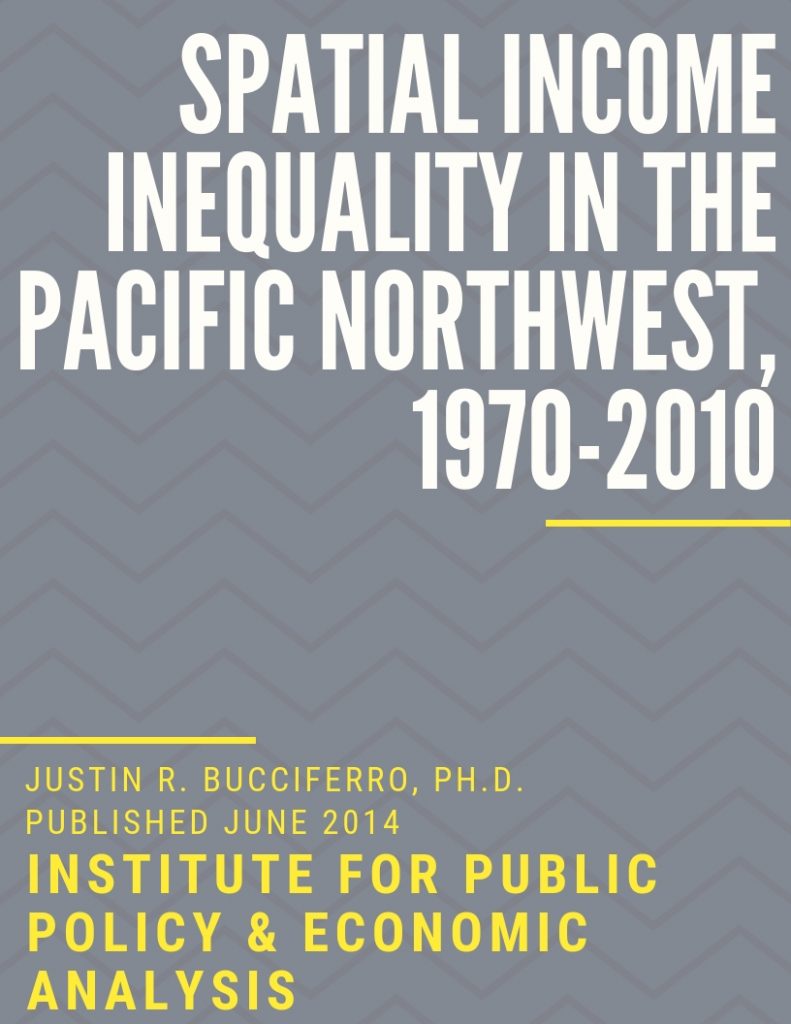
Monograph No. 18: Spatial Income Inequality in the Pacific Northwest, 1970-2010
Scholars have found that inequality is associated with lower economic growth, poor institutions, and corruption, all of which makes the economy vulnerable to crises. In this monograph, I consider the history and geography of inequality in the Pacific Northwest and nation over the past forty five years, and provide a preliminary analysis of its implications for economic growth.
Author:
Justin R. Bucciferro, Ph.D.
Department of Economics
Eastern Washington University
jbucciferro@ewu.edu
Published June 2014
Executive Summary
Full Report
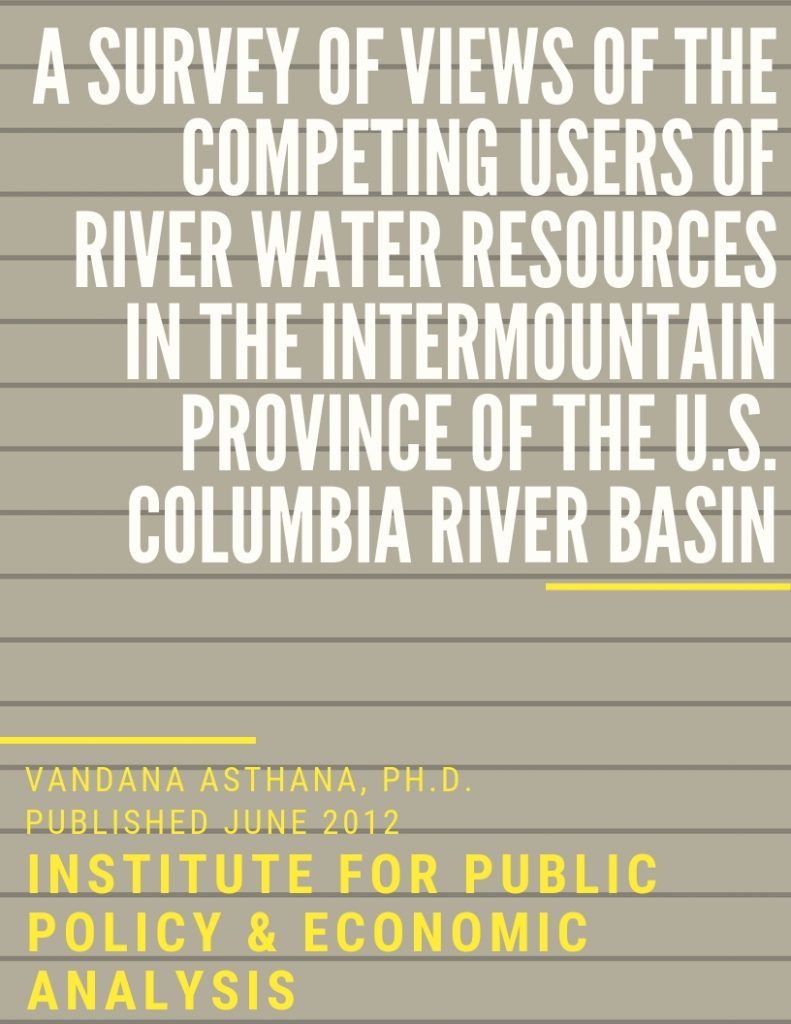
Monograph No. 17: A Survey of Views of the Competing Users of River Water Resources in the Intermountain Province of the U.S. Columbia River Basin
This monograph presents findings from a study designed to identify the competing users of water resources of the rivers in the Intermountain Province (IMP) of the Columbia River basin and their disputations. Water is the lifeline of this region and plays an important role in the sustenance of life and development of the Pacific Northwest.
As the area’s population continues to increase, it puts tremendous pressure on the resources of the rivers, creating conditions for increased competition amongst the various actors that desire a greater portion of the rivers resources. The monograph puts these trends in perspective.
Author:
Vandana Asthana, Ph.D.
Department of Goverment
Eastern Washington University
vasthana@ewu.edu
Published June 2012
Executive Summary
Full Report
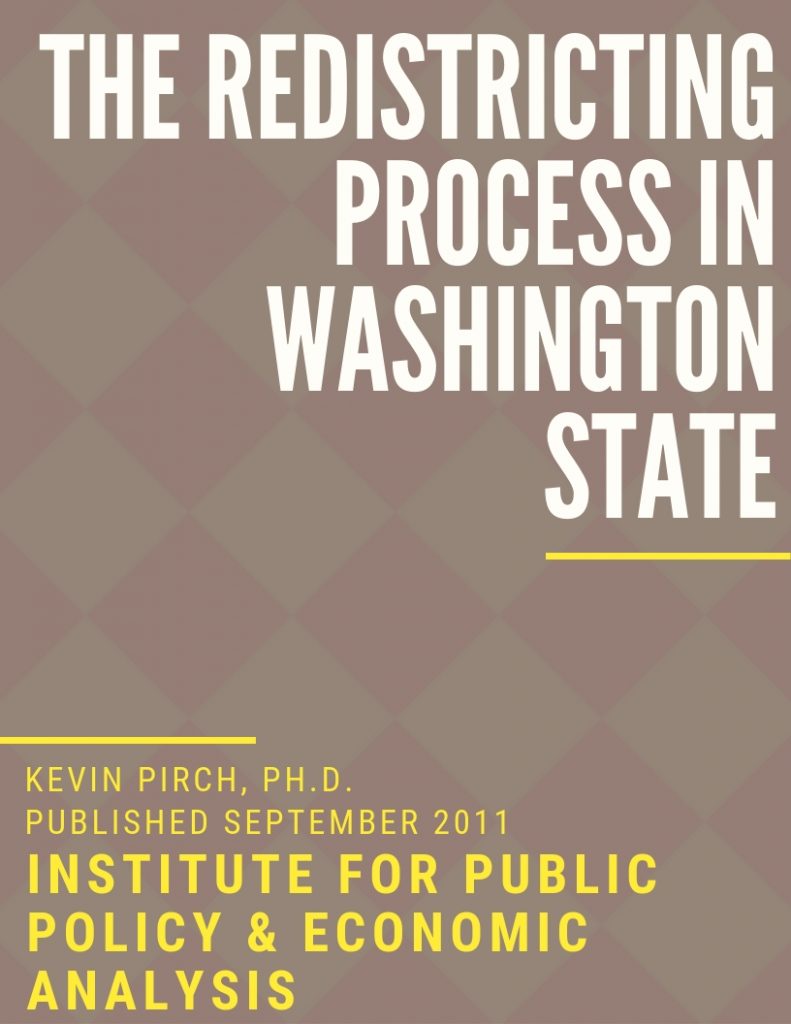
Monograph No. 16: The Redistricting Process in Washington State
Every ten years, as a result of the census, each state is required to redraw the legislative lines for both their state legislative and Congressional districts. This process has captured the imagination of politicians, academics, journalists and others who believe the political process can be manipulated by drawing lines on a map in a certain way. In the state of Washington, however, there are restrictions which limit the ability of political actors to manipulate the redistricting process.
The purpose of this monograph is to review that the popular conception of the United States’ electoral system is that the people come together and vote for their preferred candidates, and that when the ballots are counted, those with the most votes are elected.
Author:
Kevin Pirch, Ph.D.
Department of Government
Eastern Washington University
kpirch@ewu.edu
Published September 2011
Executive Summary
Full Report
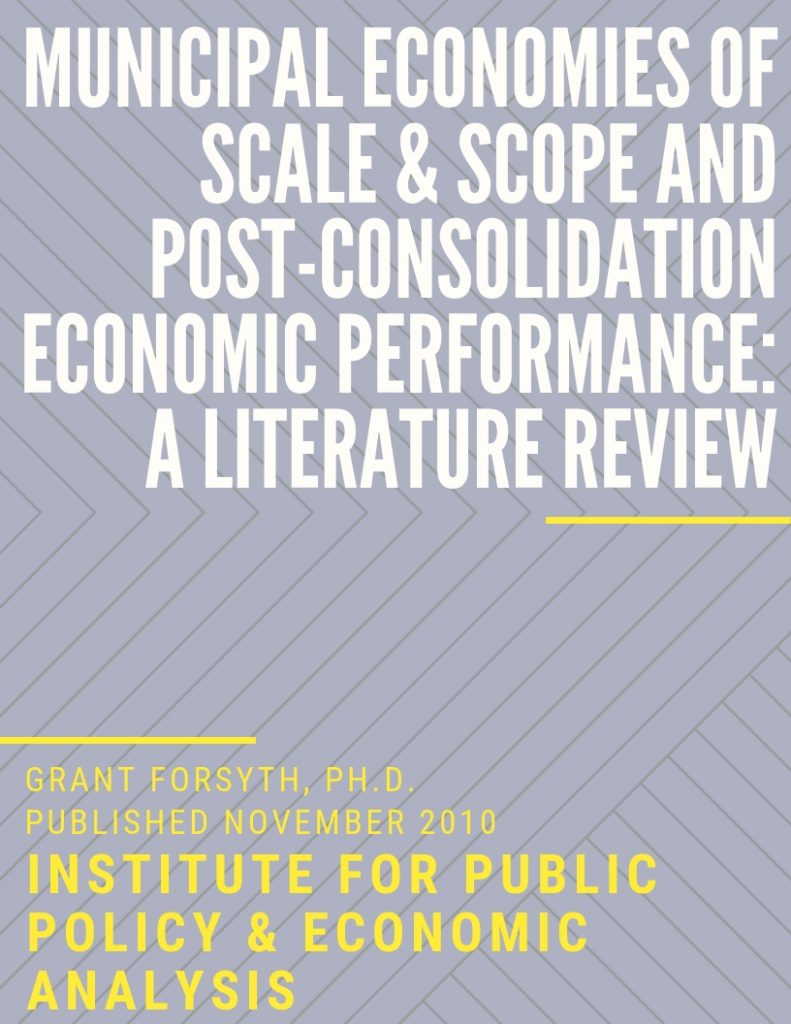
Monograph No. 15: Municipal Economies of Scale & Scope and Post-Consolidation Economic Performance: A Literature Review
Scholars have found that inequality is associated with lower economic growth, poor institutions, and corruption, all of which makes the economy vulnerable to crises. In this monograph, I consider the history and geography of inequality in the Pacific Northwest and nation over the past forty five years, and provide a preliminary analysis of its implications for economic growth.
Of particular importance are answers to the following questions: “Does increasing the size or scope of public service producers lead to lower costs per citizen served?” and “Is a county’s postconsolidation economic development significantly better than pre-consolidation development?”
Author:
Grant Forsyth, Ph.D.
Department of Economics
Eastern Washington University
Published November 2010
Executive Summary
Full Report
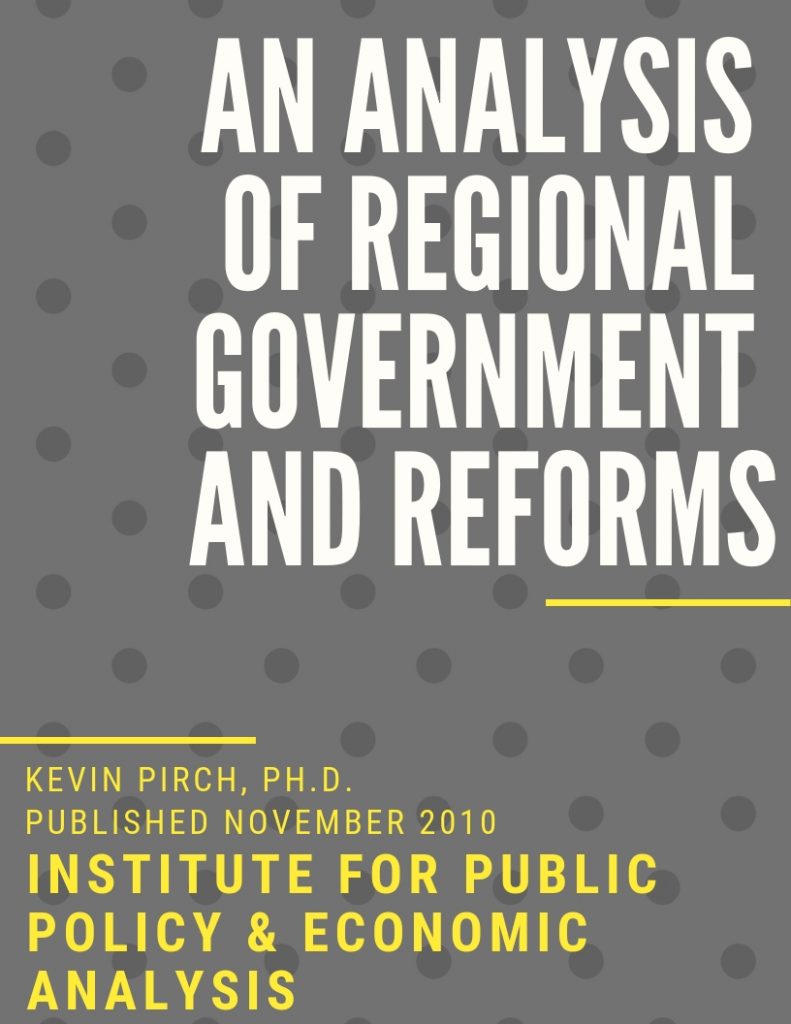
Monograph No. 14: An Analysis of Regional Government and Reforms
In the United States of America there is ample opportunity for innovation and changes to local government and solutions to regional issues. Since almost the inception of the nation, people have been innovating the structure their governments. Among the most common ways of doing this are to consolidate city and county governments, create ad-hoc solutions, such as interlocal agreements or special districts, or, to create another layer of government which focuses on regional issues. This study is a review of the literature that assesses these approaches.
Author:
Kevin Pirch, Ph.D.
Department of Government
Eastern Washington University
kpirch@ewu.edu
Published November 2010
Executive Summary
Full Report
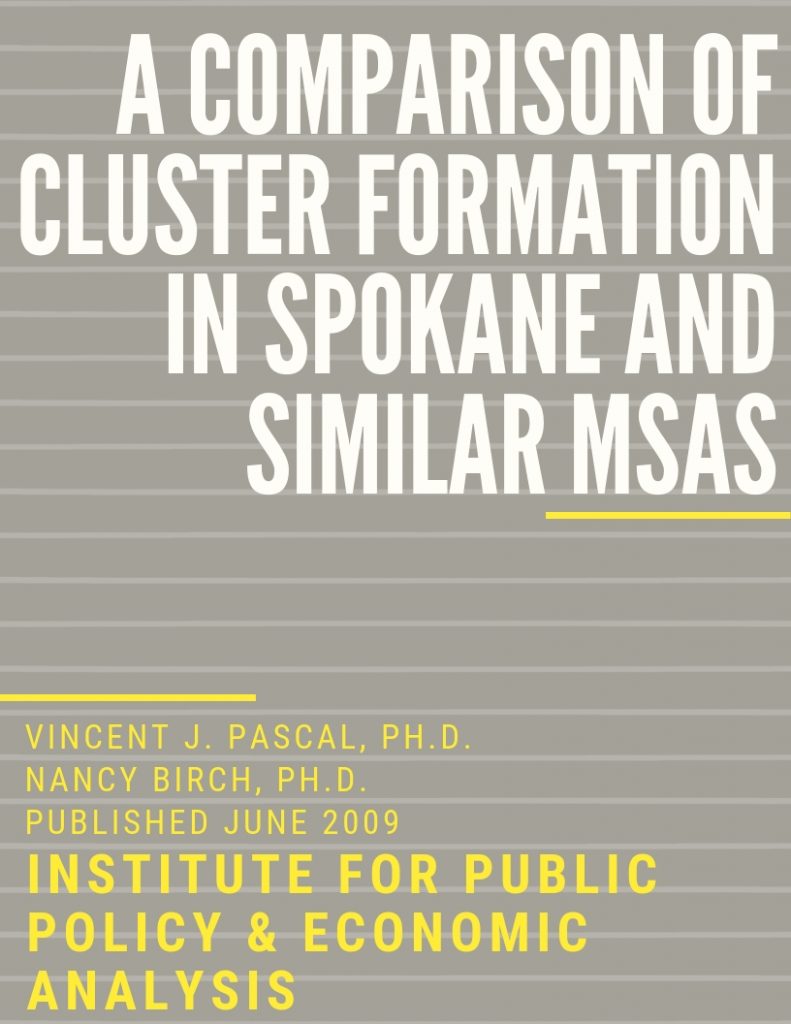
Monograph No. 13: A Comparison of Cluster Formation in Spokane and Similar MSAs
In recent years, state and local governments have looked to cluster development as a means of elevating economic performance in their regions and as a way to improve the standard of living for their constituents. This heightened interest in clusters and their formation has provided momentum to regional initiatives fostering their development. Porter (1998, 2003) shows that regions derive significant competitive and economic advantage when there are concentrations of firms (economic clusters) in home markets of similar or related industries.
The purpose of this monograph is to profile cluster as well as economic development in Spokane and seven other comparable Metropolitan Statistical Areas: Boise, ID; Colorado Springs, CO; Salt Lake City, UT; Provo, UT; Reno, NV; Tucson, AZ; and Albuquerque, NM.
Authors:
Vincent J. Pascal, Ph.D.
Department of Management
Eastern Washington University
vpascal@ewu.edu
Nancy Birch, Ph.D.
Department of Accounting and Information Systems
Eastern Washington University
nbirch@ewu.edu
Published June 2009
Executive Summary
Full Report
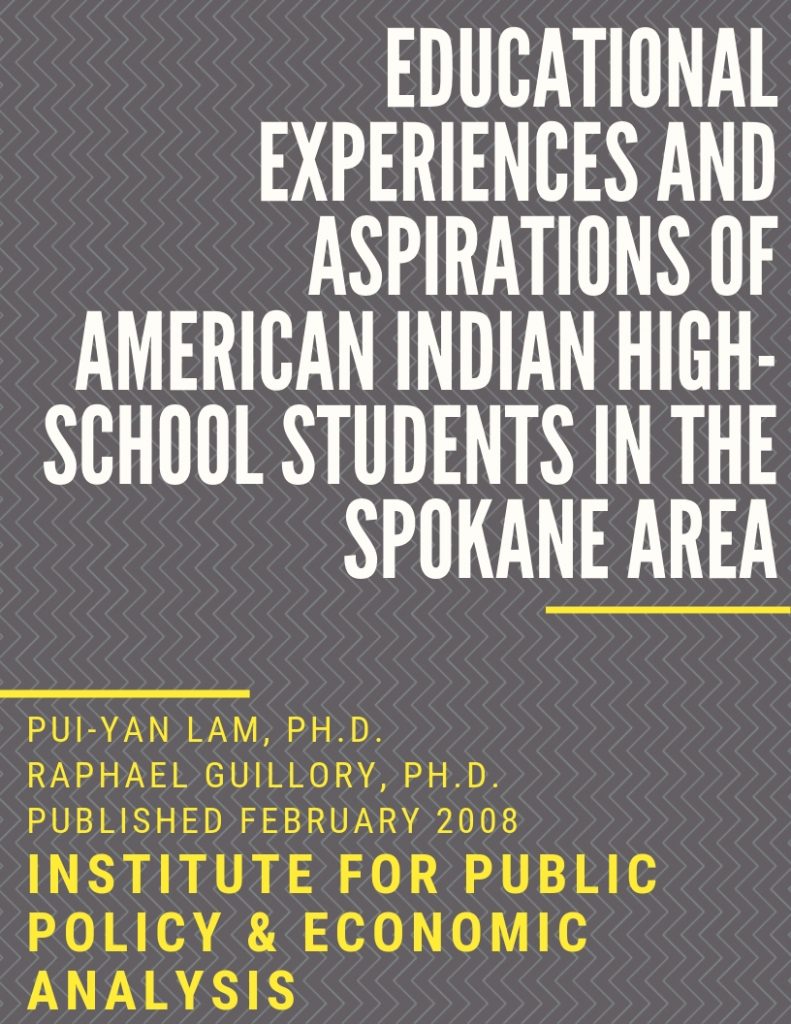
Monograph No. 12: Educational Experiences and Aspirations of American Indian High-School Students in the Spokane Area
In the United States of America there is ample opportunity for innovation and changes to local government and solutions to regional issues. Since almost the inception of the nation, people have been innovating the structure their governments. Among the most common ways of doing this are to consolidate city and county governments, create ad-hoc solutions, such as interlocal agreements or special districts, or, to create another layer of government which focuses on regional issues. This study is a review of the literature that assesses these approaches.
Authors:
Pui-Yan Lam, Ph.D.
Department of Sociology
Eastern Washington University
plam@ewu.edu
Raphael Guillory, Ph.D.
Department of Psychology
Eastern Washington University
rguillory@ewu.edu
Published February 2008
Executive Summary
Full Report
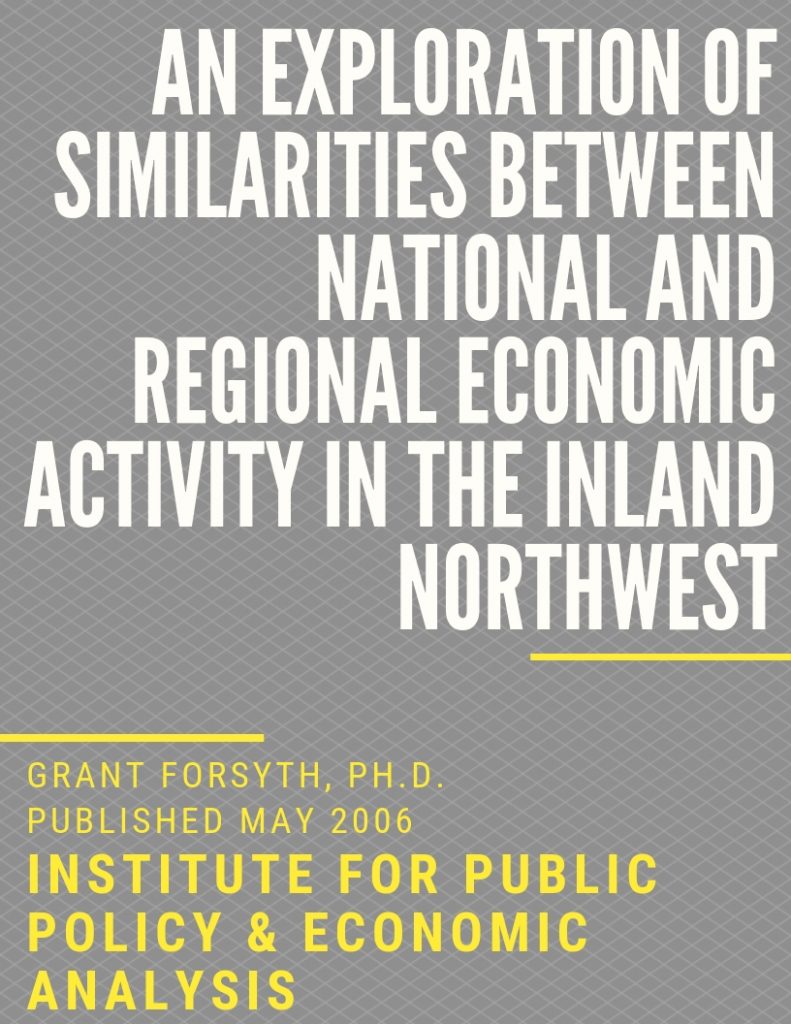
Monograph No. 11: An Exploration of Similarities between National and Regional Economic Activity in the Inland Northwest
This monograph examines the association between national economic activity and economic activity in the Inland Northwest. A common view is that the Inland Northwest does not follow the national economy very closely. However, most of the evidence put forth to support this view is largely anecdotal. Therefore, the purpose of this monograph is to examine whether or not this commonly held view is true.
This monograph’s overriding conclusion is that regional economic activity, measured by the annual growth rate of real per capita personal income for eight Inland Northwest counties, has had a historically strong association with national economic activity.
Author:
Grant Forsyth, Ph.D.
Department of Economics
Eastern Washington University
Published May 2006
Executive Summary
Full Report
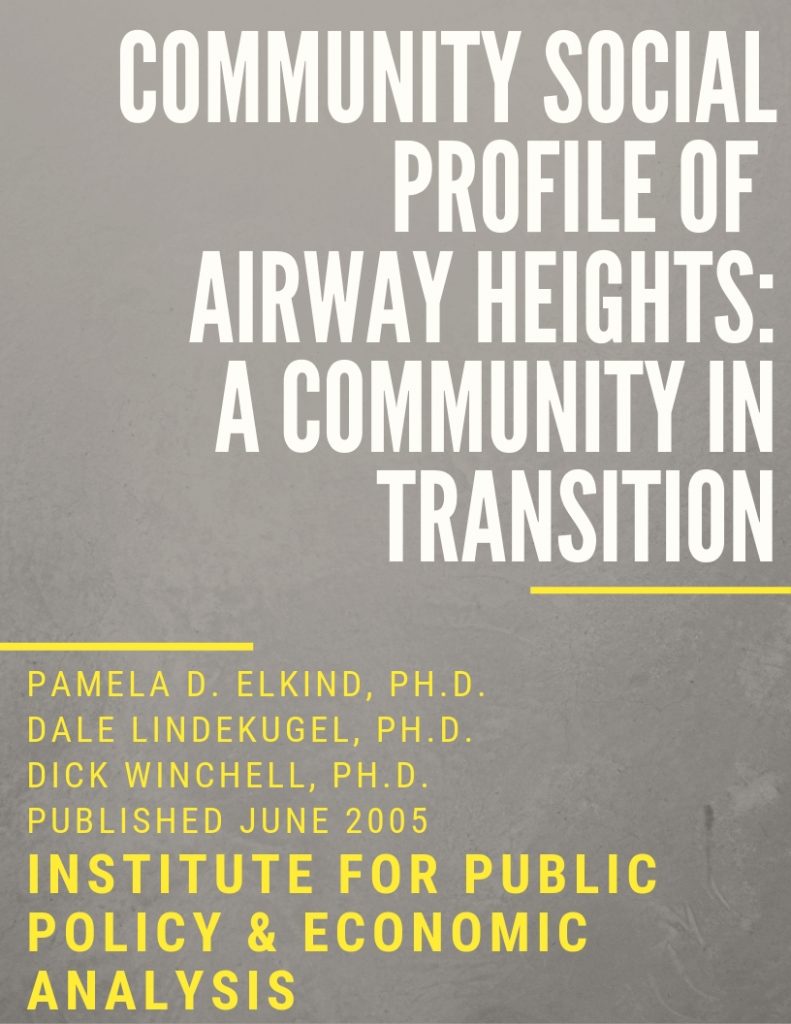
Monograph No. 10: Community Social Profile of Airway Heights: A Community in Transition
The purpose of this profile is to consider the community of Airway Heights including: the people who currently live in the city, its past, the type of community it has become, concerns that are important to residents and leaders, and its potential future. This research draws a number of conclusions about Airway Heights.
Author:
Pamela D. Elkind, Ph.D.
Department of Sociology
Eastern Washington University
pelkind@ewu.edu
Assisted by:
Dale Lindekugel, Ph.D.
Department of Sociology
Dick Winchell, Ph.D.
Department of Urban & Regional Planning
Students:
Lisa Rohrabacher, Kerry Holliday, Jon Manley, Chris Hanson, Mercy Aguilar
Published June 2005
Executive Summary
Full Report
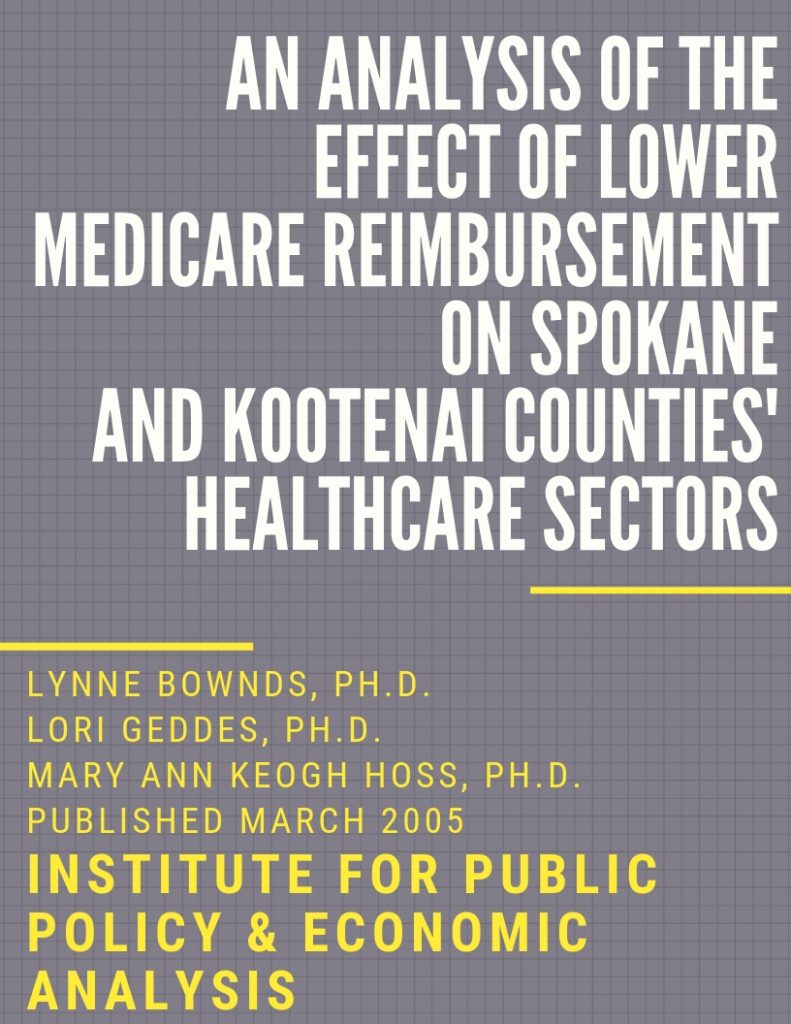
Monograph No. 9: An Analysis of the Effect of Lower Medicare Reimbursement on Spokane and Kootenai Counties’ Healthcare Sectors
The goal of this study is to measure the impact of changing Medicare reimbursements in Spokane and Kootenai Counties’ healthcare sector. Specifically the study seeks to:
- Identify the change in total Medicare income to healthcare providers.
- Examine the change in access to health care for Medicare enrollees.
- Identify the change in the mix of physician specialties.
- Determine the extent of physician “flight”.
Authors:
Lynne Bownds, Ph.D.
Department of Economics
Eastern Washington University
Lori Geddes, Ph.D.
Department of Economics
Eastern Washington University
Mary Ann Keogh Hoss, Ph.D.
Department of Health Services Administration
Eastern Washington University
mhoss@ewu.edu
Published March 2005
Executive Summary
Full Report
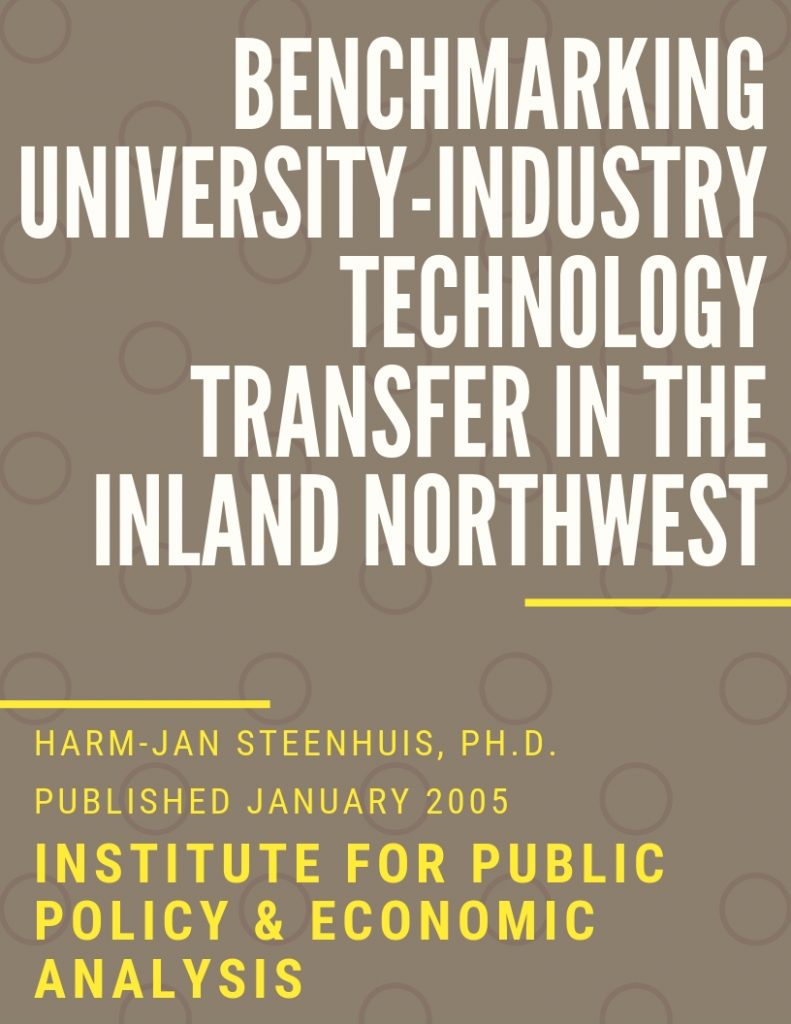
Monograph No. 8: Benchmarking University-Industry Technology Transfer in the Inland Northwest
This monograph presents the first of a two-part research study focused on technology transfer in the Inland Pacific Northwest. This part presents benchmark findings about technology transfer at the Inland Northwest research centers: Eastern Washington University (EWU), University of Idaho (UI), Washington State University (WSU) and Pacific Northwest National Laboratory (PNNL).
Author:
Harm-Jan Steenhuis, Ph.D.
Department of Management
Eastern Washington University
Published January 2005
Executive Summary
Full Report
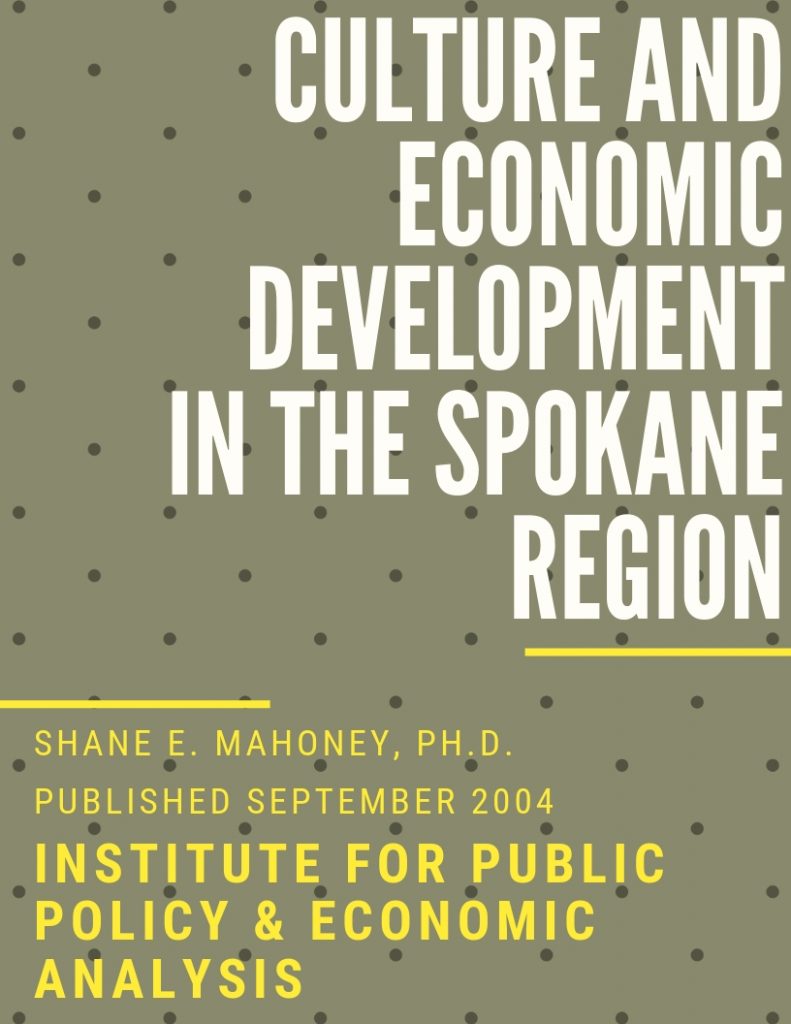
Monograph No. 7: Culture and Economic Development in the Spokane Region
Through in-depth interviews with leading commercial, political, academic research and university persons, the research described in this report undertook to identify the main characteristics of economic culture in the Spokane region. In addition, a smaller number of similar interviews were conducted with industrial leaders in the Boise, Idaho area. Findings from both of these regions were then compared with the benchmark economic-cultural traits displayed in the Silicon Valley.
Author:
Shane E. Mahoney, Ph.D.
Department of Government
Eastern Washington University
Published September 2004
Executive Summary
Full Report
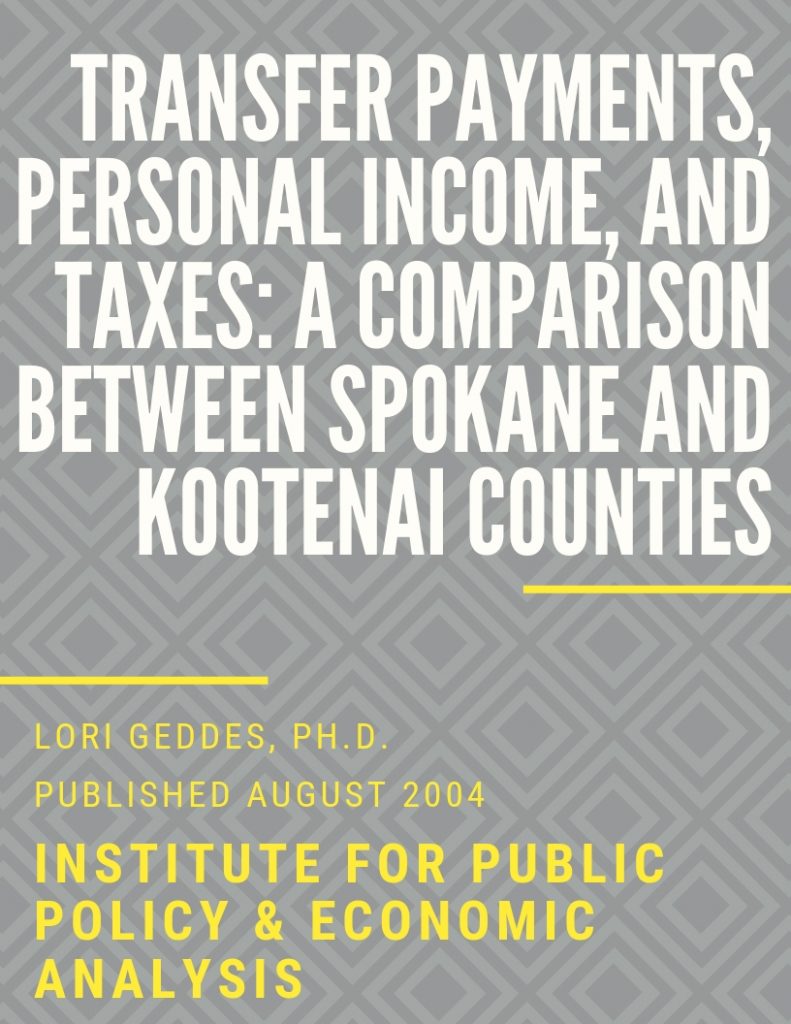
Monograph No. 6: Transfer Payments, Personal Income, and Taxes: A Comparison Between Spokane and Kootenai Counties
This report explores the trends in transfer payments and personal income for Spokane and Kootenai Counties over a 31-year period from 1971 to 2001. This allows us to see the role the government plays in providing economic support to the area and how dependent the two counties are on federal transfer payments.
Author:
Lori Geddes, Ph.D.
Department of Economics
Eastern Washington University
Published August 2004
Executive Summary
Full Report
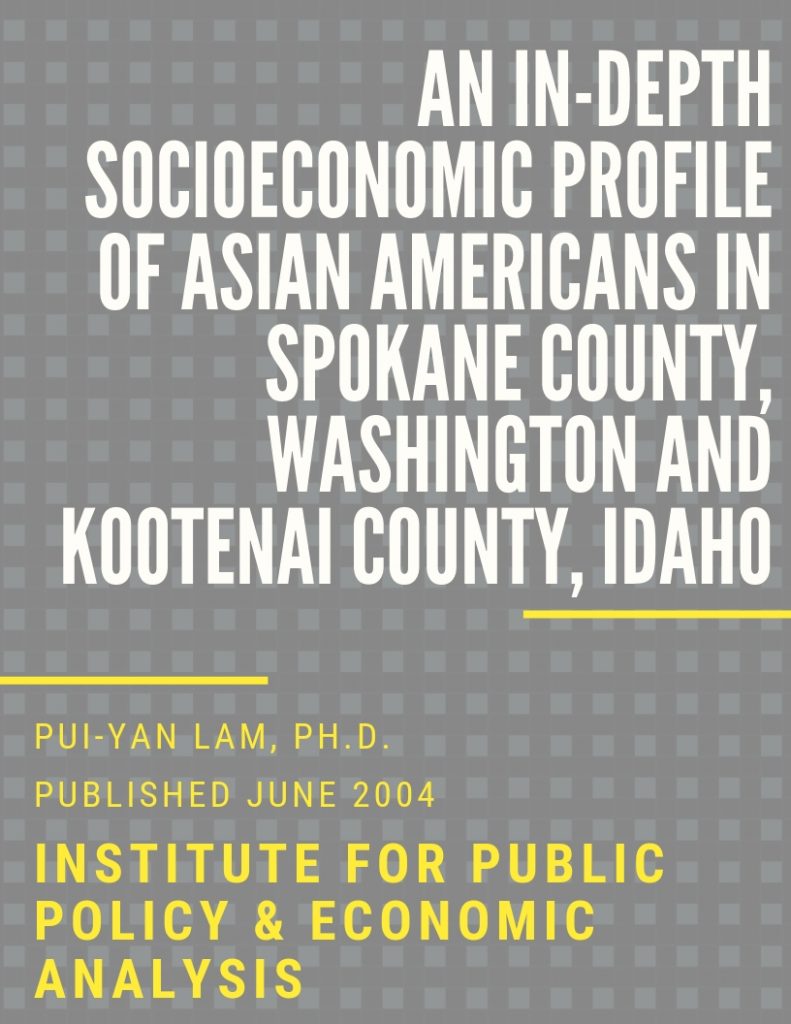
Monograph No. 5: An In-Depth Socioeconomic Profile of Asian Americans in Spokane County, Washington and Kootenai County, Idaho
This monograph presents the first research study that specifically investigates the current status of Asian Americans in the Inland Northwest. Using data from the 2000 Census, it provides an in-depth socioeconomic analysis of the seven largest Asian American populations in Spokane County, Washington and Kootenai County, Idaho.
Author:
Pui-Yan Lam, Ph.D.
Department of Sociology
Eastern Washington University
plam@ewu.edu
Published June 2004
Executive Summary
Full Report
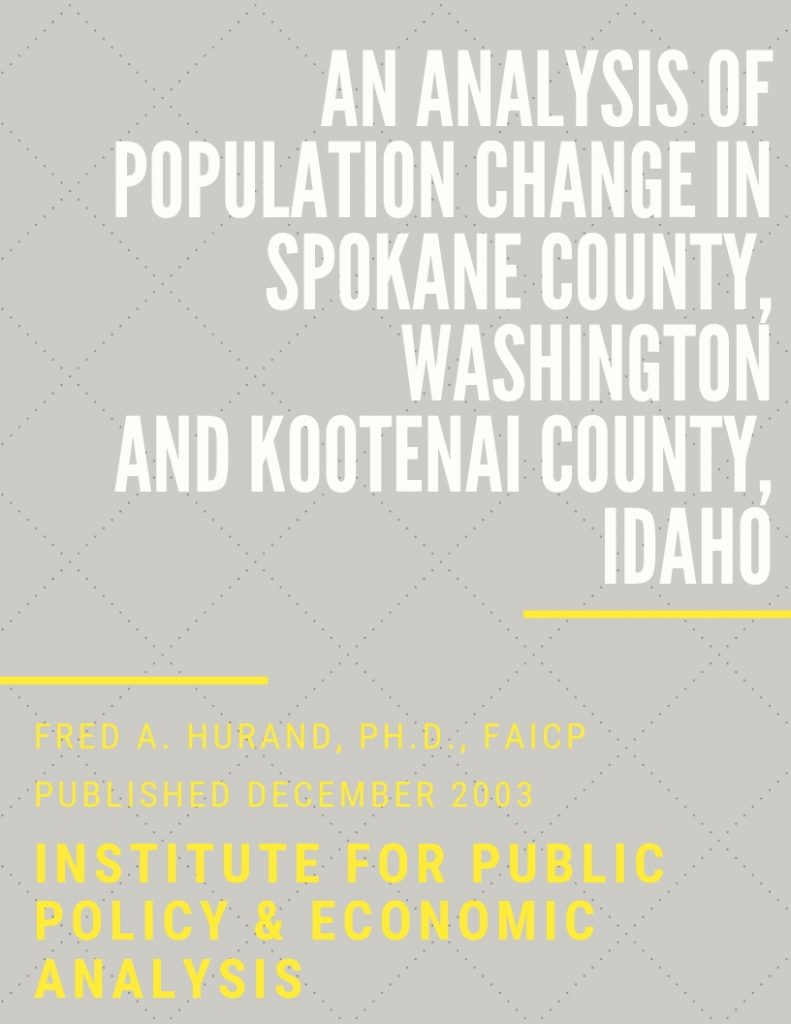
Monograph No. 4: An Analysis of Population Change in Spokane County, Washington and Kootenai County, Idaho
Spokane County, Washington and Kootenai County, Idaho encompass the largest single population center between Seattle and Minneapolis across the northern tier of the United States. As of the 2000 census, 526,624 people live in this two-county region. Since 1980, the population has increased 31%, with over 75% of that growth occurring in the 1990s. Regional decision-making and planning are dependent upon understanding these rates of growth, the changes in the general characteristics of the population and what can be anticipated as future growth. This report describes these factors.
Author:
Fred A. Hurand, Ph.D., FAICP
Department of Urban Planning, Public and Health Administration
Eastern Washington University
Published December 2003
Executive Summary
Full Report
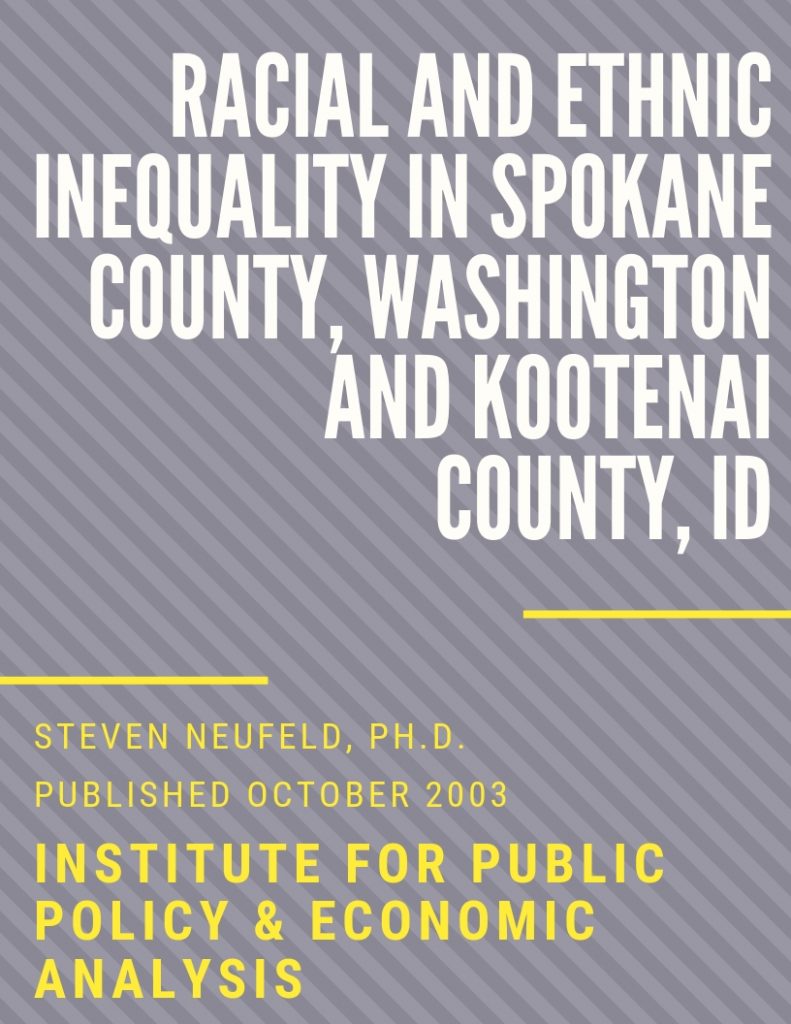
Monograph No. 3: Racial and Ethnic Inequality in Spokane County, Washington and Kootenai County, Idaho
The second of this two-part study presents census data on racial and ethnic inequality in Spokane and Kootenai Counties for the major racial and ethnic groups defined in the U.S. Census. It examines racial and ethnic inequality in education, labor force participation, full-time employment and earnings, income and poverty.
Author:
Steven Neufeld, Ph.D.
Department of Sociology
Eastern Washington University
Published October 2003
Executive Summary
Full Report
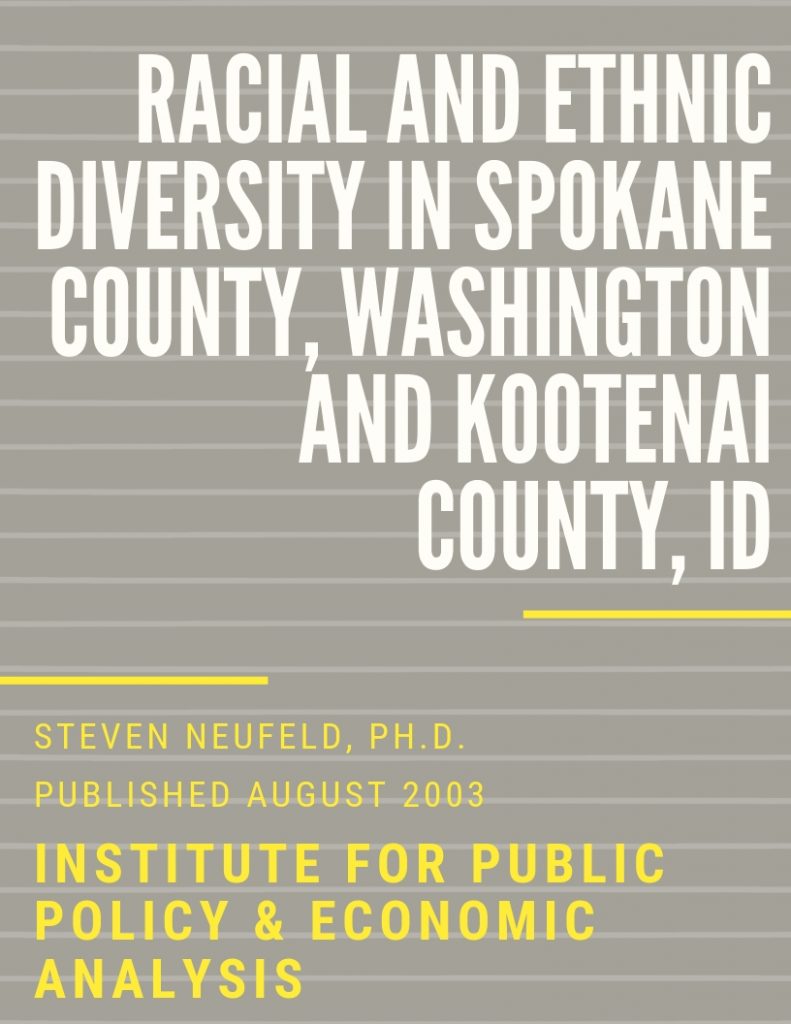
Monograph No. 2: Racial and Ethnic Diversity in Spokane County, Washington and Kootenai County, Idaho
The first of this two-part study presents census data on racial and ethnic diversity in Spokane and Kootenai Counties for the major racial and ethnic groups defined in the U.S. Census. It examines the racial and ethnic makeup of the population for the two counties, including data on ancestry and foreign-born populations in the two counties.
Author:
Steven Neufeld, Ph.D.
Department of Sociology
Eastern Washington University
Published August 2003
Executive Summary
Full Report
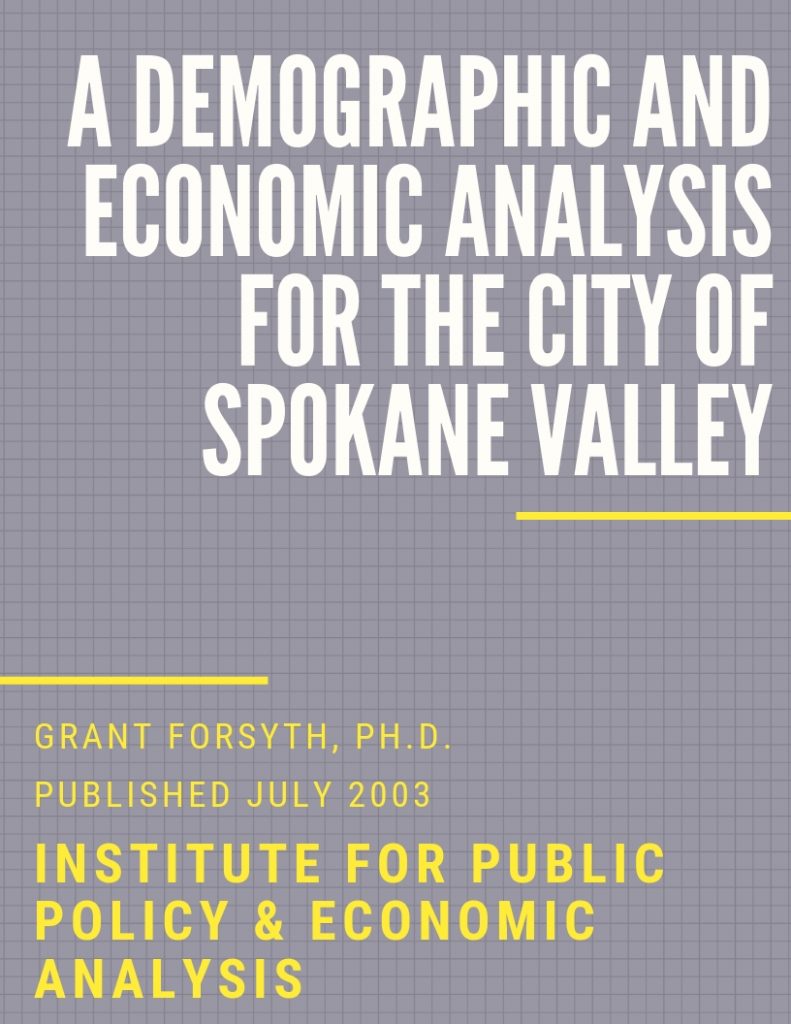
Monograph No. 1: A Demographic and Economic Analysis for the City of Spokane Valley
The purpose of this analysis is to provide an overall socio-economic picture of the City of Spokane Valley’s economy. The analysis is divided into three parts. The first part analyzes sources of employment and data on employers, employees, the pattern of small business lending and export markets. The second part analyzes population demographics and presents data on age, race, family size, housing characteristics and educational attainment. The third part analyzes incomes, the distribution of incomes and poverty rates.
Author:
Grant Forsyth, Ph.D.
Department of Economics
Eastern Washington University
Published July 2003

